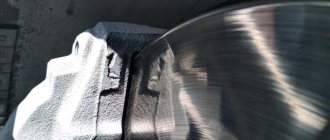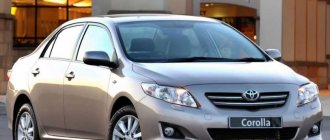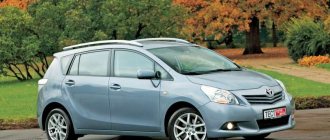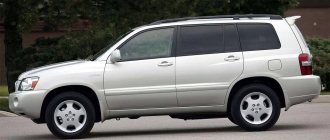The ninth generation Toyota Corolla E120 was the concern’s most popular model at the time of its release. It remains so today. The Corolla sedan of the E120 format has standard overall dimensions of its class. Of the most important dimensions of the Toyota Corolla, the width, length and height of the body should be noted. The car is 4375 mm long, 1710 mm wide and 1470 mm high. Also, all cars of this family have the same wheelbase - 2600 mm and track width, at the front it is 1490 mm, at the rear - 1470 mm. The amount of clearance is very important. For this model it is 160 mm, which is comparable to its size for most domestic cars. The trunk volume also has standard values - within five hundred liters.
Why do you need to know geometric body dimensions?
The ninth generation Toyota Corolla stopped rolling off the company's production lines more than a decade ago, however, thanks to its reliability, this car is well-deservedly popular in the secondary market.
It goes without saying that the vast majority of used cars have fairly high mileage.
The impact of shock loads that the suspension is unable to soften, minor and serious accidents lead to the fact that the body geometry may be somewhat disrupted.
On the other hand, it is the geometric dimensions of the body that can tell a lot about the nature of the vehicle’s operation.
The most common reason why body dimensions are needed is to match the dimensions of the car and the future owner. In this regard, the Corolla E120 sedan is fully in line with its class.
Other parameters of Toyota Corolla E120:
| Total weight of the Toyota Corolla E120 | |||
| General view General view of the car | Curb weight min (kg) Minimum vehicle weight for different modifications of Toyota Corolla E120 | ||
Data are presented in kilograms (kg)
Caution: the above data are official figures from manufacturers, however, please note that the information is for reference only and does not guarantee absolute accuracy.
Source
How to determine compliance with body geometry
The technical documentation for the Toyota Corolla shows body control points linked to each other. Knowing the exact values of the distances between them, you can determine how great the deformation of the car body is and whether it is possible to restore it. Unfortunately, this information on existing Corolla sizes is available only to service center employees.
For ordinary car owners, the control points of the Toyota Corolla body geometry are not available, therefore, to determine the quality of the body of the purchased car, the presence of a qualified specialist is required.
Technical characteristics of Toyota Corolla
Toyota Lyubertsy and Toyota Izmailovo dealerships offer five trim levels of the new sedan - Standard, Classic, Comfort, Prestige and Prestige Safety. You can make a choice based on your preferred body color, transmission type, set of options and cost.
Technical characteristics of Toyota Corolla:
- 1.6 liter naturally aspirated petrol engine, adapted to the AI-92.
- Front-wheel drive with continuously variable CVT and 6-speed manual transmission.
- Acceleration to 100 km/h 10.8/11.0 s depending on transmission type.
- Combined cycle consumption 6.4 and 6.6 liters for trim levels with manual transmission and
Leave a request for a consultation on the website. The manager will contact you and answer all questions.
| Parameter | Toyota Corolla 1.33 99 hp | Toyota Corolla 1.6 122 hp | Toyota Corolla 1.8 140 hp | |
| Engine | ||||
| Engine code | 1NR-FE | 1ZR-FE | 2ZR-FE | |
| engine's type | petrol | |||
| Injection type | distributed | |||
| Supercharging | No | |||
| Number of cylinders | 4 | |||
| Cylinder arrangement | in-line | |||
| Number of valves per cylinder | 4 | |||
| Volume, cubic cm. | 1329 | 1598 | 1798 | |
| Cylinder diameter/piston stroke, mm | 72.5×80.5 | 80.5×78.5 | 80.5×88.3 | |
| Power, hp (at rpm) | 99 (6000) | 122 (6000) | 140 (6400) | |
| Torque, N*m (at rpm) | 128 (3800) | 157 (5200) | 173 (4000) | |
| Transmission | ||||
| Drive unit | front | |||
| Transmission | 6 manual transmission | 6 manual transmission | variable speed drive | variable speed drive |
| Suspension | ||||
| Front suspension type | independent MacPherson type | |||
| Rear suspension type | semi-dependent | |||
| Brake system | ||||
| Front brakes | ventilated disc | |||
| Rear brakes | disk | |||
| Steering | ||||
| Amplifier type | electric | |||
| Tires and wheels | ||||
| Tire size | 195/65 R15 / 205/55 R16 | |||
| Disk size | 6.0Jx15 / 6.5Jx16 | |||
| Fuel | ||||
| Fuel type | AI-95 | |||
| Environmental class | Euro 5 | |||
| Tank volume, l | 55 | |||
| Fuel consumption | ||||
| Urban cycle, l/100 km | 7.2 | 8.7 | 8.2 | 8.3 |
| Extra-urban cycle, l/100 km | 4.7 | 5.4 | 5.3 | 5.3 |
| Combined cycle, l/100 km | 5.6 | 6.6 | 6.3 | 6.4 |
| dimensions | ||||
| Number of seats | 5 | |||
| Number of doors | 4 | |||
| Length, mm | 4620 | |||
| Width, mm | 1775 | |||
| Height, mm | 1465 | |||
| Wheelbase, mm | 2700 | |||
| Front wheel track, mm | 1515 | 1510 | ||
| Rear wheel track, mm | 1535 | |||
| Front overhang, mm | 940 | |||
| Rear overhang, mm | 980 | |||
| Interior dimensions LxWxH, mm | 1930×1485×1190 | |||
| Trunk volume, l | 452 | |||
| Ground clearance (clearance), mm | 150 | |||
| Weight | ||||
| Curb (min/max), kg | 1225/1355 | 1260/1375 | 1260/1375 | |
| Full, kg | 1735 | 1775 | 1785 | |
| Weight of towed trailer (equipped with brakes), kg | 1000 | 1300 | ||
| Weight of towed trailer (not equipped with brakes), kg | 450 | |||
| Dynamic characteristics | ||||
| Maximum speed, km/h | 180 | 195 | 185 | 195 |
| Acceleration time to 100 km/h, s | 12.6 | 10.5 | 11.1 | 10.2 |
Review of Toyota Corolla 1.4 16v VVT-i (2005)
Good day to all readers!
So, in October 2010, I had luck - my father decided to exchange his car for a new one, and gave me the old Corolla (in the base version with a 1.4 liter engine) Actually, that’s why I decided to write a review now - at least I drove it I don’t know much about it, but I know the entire history of this car for all 68 thousand kilometers.
First impression
Before the Corolla, I drove a pretty good car - the Hyundai Getz, with which I will mainly compare (because I haven’t driven much in other cars of the Corolla class, only if it was a corporate focus, and then as a passenger). My first impression was “how convenient everything is here!” The gearshift knob is located close to the steering wheel and quite high, and its strokes are also very short, I have wanted this for a long time. It doesn’t have that “toy” lightness, but that’s even better. Next, the steering wheel - its shape and tactile sensations are very pleasant, the reach adjustment is also very pleasing. I especially want to say about the electric booster: in a parking lot, the difference with power steering is the same as between a car without a booster at all and a car with power steering - you can turn it with one finger, it’s very convenient. In addition, as the speed increases, the steering wheel becomes heavier, and not vice versa, as in a Getz with power steering. The interior is soft to the touch, all electric windows are pulsed (all 2 :)))) The standard music does not read MP3 and of course there is no USB port. I'm glad that it's 2-din - it will be possible to install something serious. The only thing I didn’t like was the completely stupid backrest tilt adjustment system. I don’t even know how to describe this mechanism. They probably wanted to make it infinitely adjustable and it worked out, but... In general, it is a plastic thing that you can pull up and push down. When you press down/up, the backrest tilts forward/back accordingly. If the tilt needs to be adjusted, then this is certainly convenient. But if you want to lie down, then you have to sit and lift this handle 30 times - lifted it, let it go... And then back again... Nonsense... And the amount of space in this car is huge: even with the seat fully raised, I don’t rest my head on the ceiling (height is 182cm) . I think a person 2m tall can sit there.
Driving performance and operating features
When driving, the car is very soft, many speed bumps can be walked over, but it’s better not to abuse it. The controllability caused mixed feelings: the feedback in the near-zero position of the steering wheel is very weak, I don’t know what this is connected with, whether this is how the EUR works, or whether the rack is dying (according to statistics, the rack on Corollas only lasts 50-60 thousand, this is their common disease ). And in corners the car behaves very well (thanks to the independent rear suspension and standard Michelin tires), the feeling of confidence in the corner still did not leave me, and the rolls are not great (again, compare with Getz). I also want to say that during all this time the interior is noisy at all; in fact, the only extraneous sound that accompanies the movement is like the wire from the radar detector knocking on the panel - I have not yet figured out how to remove it. When the car first came to me, the license plate on the back door was rattling - I made spacers from 2-sided tape - it became quiet. In general, for the 6th year of life - a very high-quality interior.
And in general, no matter what anyone says, but Toyotas have very competent equipment, the base has ABS, 4 airbags, air conditioning, electric mirrors, 2 impulse lifts, heated seats, electric headlight adjustment - everything I need, not at all no more and no less.
What else is worth saying about the driving performance of the car. Engine 1.4... It doesn't drive. This is probably exactly how it can be written. For the city it is quite enough (at low speeds you just drive, after 4 thousand you can pick it up, you can even rock it), but on the highway it is not enough. Purely for safety reasons, it is better to prefer 1.6 and not prolong the pleasure of overtaking in oncoming traffic. About the expense. Do you think, “but 1.4 eats little”? No, absolutely not. I’m used to driving aggressively, and if I drive the way I’m used to and want, that is, in my own style, she eats the same 10-10.8 (comp — 10.5, real 10.8, winter) liters per hundred. I think if there were 1.6, the consumption would be the same, or 11 liters, for example. And in general, consumption at such volumes depends more on the style than on the engine. Today I drove for efficiency, not slowly, but not as always. As a result, on the route home-work-home, the average consumption on the computer was 7.3 liters per 100 km. At night, I think, you can drive it at 6, and in annealing during rush hour at 15. It eats 92, in general everyone advises pouring 92 into Toyotas (a friend in the office service). In general, it’s up to you to draw your own conclusions. As for the kondeya: such a sharp drop in traction as in the Getz is not felt, I don’t understand at all what the reason is... Consumption +0.5l (measured instantaneously at a speed of 80 km/h). Yes, by the way, the car moves much more confidently at speed, but it’s hard to accelerate. I haven’t driven more than 160 yet, but it’s quite possible to move around on these 160 (again, 135 is much worse in OK).
I can also add that in dirty weather, the side mirrors and windows remain clean for a very long time and practically do not get dirty at all (in Goetz it’s the other way around). Well, the final touch is that it has a very short clutch, which is a plus for me, but when I drove it around the autodrome, when I was learning to drive, it was difficult to drive onto an overpass. The headlights shine perfectly, there is a separate light bulb for high and low beams + adjustable - excellent (we did not experience such happiness in the Getz).
Yes! I forgot the most important thing. Ground clearance - it is huge (after Getz). In reality, you drive much more calmly, real 160mm (well, the Getz doesn’t even have the stated 145, 110 is the maximum there). Here I can make a comparison with the now popular trick of the 2nd latest restyling: a corporate car, when entering a parking lot in winter, mercilessly scrapes its belly, the Corolla passes calmly and with reserve. The only thing is that the front overhang is long, due to this the approach angle on it is not so great.
What I forgot to say. The instrument lighting here is made in an unusual way - when you drive during the day with the headlights off, it lights up brightly and everything is visible. When it gets darker and a person turns on the headlights, it dims and doesn’t dazzle... That’s what they were counting on. But now you always have to drive with lights on. As a result, during the day I sometimes don’t see how much fuel is left there and what mileage I have... The speed is even more or less readable, but still not without tension. If anyone knows how to solve this problem, I would be glad for advice. There is no brightness adjustment.
Reliability and cost of maintenance
The reliability of the car has not yet caused any complaints. During the entire 70 thousand, only the oxygen sensor in the engine broke down (at 3 thousand km, it was replaced under warranty). However, not everything is so rosy and good, namely: the steering rack promises to be covered soon, and that’s 30k rubles. Well, until it’s over and okay :) Next, the cost of maintenance. There is little joy here either. There were 2 expensive maintenance services, 40 thousand and 60 thousand km. At 40, we changed all the pads + rear brake discs (in addition to standard oil and filters) - 28 thousand rubles (!!!!). We replaced the front brake discs for 60 thousand, I don’t remember exactly, but it also cost about 20 thousand. In general, although the machine does not break down, it loves money. These maintenance were carried out at the office. dealer. I do not intend to continue to be serviced there in the future; I cannot afford it.
Of the light fixtures, one low beam bulb in the interior lamp, part of the panel illumination (the knobs responsible for the operation of the air conditioning system and stove) burned out. The only thing I didn’t change was in the panel - I don’t know how to take it apart, and I’m afraid to poke around, putting it together sucks - there are creaks, the crickets will start.
Rubber
By tradition, I’ll add a small off-topic about tires (who read my reviews about Getz). So, it has been wearing Bridgestone Ice Cruiser 5000 tires for all these 6 winter seasons. It looks almost like new... And this is not because it holds the road so well))) It behaves simply awful. On asphalt there is a hellish roar at speeds of 40-60 km/h - the most urban mode. If the asphalt is covered with snow, it’s the finish line; it brakes and steers not much better than a summer tire (when the first snow fell, I had already put it on, and that night I was driving home, in front of me our Russian VAZ 2109 braked to the floor on summer tires, and I barely made it stop at winter and with abs... horror!). The behavior in the snow at speed is also terrible, you constantly catch the car drifting backwards. In general, I remembered winter driving on OKE on a Kama... The only advantages of this tire are durability and cross-country ability (the car rushes well in snowdrifts). In general, it is not comparable to Hakka.
Yes, and the standard Michelin (made in Germany), which is also already 6 years old, behaves excellently, although it no longer looks new, but nevertheless it is very comfortable and steers well (for which, however, I paid the price - I tore one wheel in a pit this spring, the disk is intact).
Conclusion
As a conclusion, I can say that the car does the main thing - it takes me from point “a” to point “b” and at the same time brings me joy :) It is very comfortable and I really like it, that says it all. There are no cars without flaws.
4* in driving performance only because of the engine.
PS In the review there is not a word about the appearance, it’s all about the taste and color... I like it, what else can I say)
Our advantages
- Specialization only in Toyota cars
- Special equipment
- Original spare parts
- Direct acceptance
- Coordination of all additional work
- Opportunity to monitor the progress of work
- Friendly staff
- Enjoy your time at the dealership
- Special promotions and offers
The Toyota Corolla is a best-selling automobile and has been selling widely since 1966. The current latest generation appeared before the general public in 2021 and is already the twelfth generation of the model. It received the E210 index, a different platform, the same set of units, an expanded list of equipment, a redesigned interior, and a new design. The front end features narrow, tapered headlights with LED daytime running lights. The radiator grille has a purely decorative function and consists of a black trim with a chrome insert and the manufacturer’s logo. Below it is a massive air intake, consisting of many tightly fitted fins. On the sides of it you can see small recesses with fog lights and C-shaped chrome trims.
dimensions
There have been important changes to Toyota's lineup. Previously, the hatchback and station wagon based on the Corolla bore the name Auris, but from the 12th generation, all bodies belong to the same model and this division will no longer exist. True, there are no plans to deliver anything other than a sedan to Russia yet. In this version, the car has the following overall dimensions: length 4630 mm, width 1780 mm, height 1435 mm, and wheelbase 2700 mm. Ground clearance, like most city cars, is 150 millimeters.
One of the global changes for the Corolla E210 was the transition to the new modular TNGA platform. It retained the typical layout for this class with a front transverse power unit and McPherson struts at the front. At the same time, the rear of the chassis has noticeably changed. Instead of a semi-independent torsion beam, a completely independent multi-link structure is installed. The trunk size has increased to 470 liters.
A brief history of the Toyota Corolla E120: what makes the model memorable?
Serial production of the car began at the beginning of 2001 with a completely redesigned car design - in the new Corolla, the exterior of the car was modified, and the interior was also modified to increase functionality.
The main feature of the car was the new body, which received a more aggressive design and an increased layer of anti-corrosion treatment: the depth of the galvanized coating of the car is 5-15 microns, which completely prevents the body from rotting. Without mechanical deformation, the car skin can withstand any climatic conditions. Also on the E120, the algorithm for applying paintwork to the car body was redesigned, resulting in increased paint protection from accidental damage and fading in the sun.
The Toyota Corolla E120 was produced in three body variations - models were supplied to the market in sedan, hatchback and station wagon versions, the design features of which differed depending on the market category: cars for the American and European markets have incompatible parts.
The large-scale production of the E120 continued until 2006 until the release of the new generation of Corolla E150. However, due to the limitations of the new model - the E150 was produced only in a sedan version, the E120 remained popular for a long period of time.
This is interesting! The Toyota Corolla E120 model entered the Guinness Book of Records as the best-selling car in history - over the entire history of production, more than 40 million cars were sold across all continents in the world.
Specifications
For cars supplied to the domestic market, only one power unit will be offered. This is a 1.6-liter in-line naturally aspirated petrol four. It has two camshafts, a multi-point fuel delivery system and a proprietary VVT-i variable valve timing system on each shaft. As a result, the engineers managed to squeeze out 122 horsepower at 6050 rpm and 153 Nm of torque at 5200 rpm. Transmission options include a six-speed manual or CVT. Front wheel drive only. Depending on the type of gearbox, acceleration to a speed of one hundred kilometers per hour will take from 10.8 to 11 seconds, and the speed ceiling will be at around 185-195 kilometers per hour. Fuel consumption in the combined driving cycle will be 6.3-6.6 liters.
Weaknesses and vulnerabilities of the car: where can we expect trouble?
The guaranteed service life of the car reaches 250,000 km with an automatic transmission and up to 300,000 km with a manual transmission. Until the end of the component life, the following problems may occur:
- Vibration at idle – increased vibration load is a design feature of this type of engine and cannot be eliminated. If vibration is transmitted to the car body, it is recommended to turn on additional electrical consumers or fill in high-octane fuel;
- Lack of hydraulic compensators - this problem forces the valves in the engine to be calibrated every 100,000 km. It is recommended to entrust repairs to certified specialists, otherwise the engine service life may be reduced;
- Problems with catalysts and increased oil consumption - to eliminate the situation it is necessary to use high-quality fuel and consumables. E120 engines operate stably only on high-octane fuel, and the use of gasoline of a grade lower than A95 is fraught with overheating of components and the appearance of detonation shocks.
Regular replacement of consumables and timely maintenance of the vehicle will increase the service life of the vehicle and reduce the likelihood of accidental breakdowns.
equipment
Five different trim levels with different levels of equipment have been prepared for the Toyota Corolla. Base models will, for the most part, only get basic safety equipment, such as front and side airbags, ABS, BAS, ESP and ASR, child seat anchors, a standard alarm, light sensor and air conditioning. For an additional fee, you can order a car with leather trim, alloy wheels, an electronic instrument panel, an advanced multimedia system, keyless entry, parking radar, a rear view camera, a traffic sign recognition system, as well as active cruise control and a head-up display.
video
Another characteristic feature is the height of the car. Toyota Corollas are quite tall cars due to their raised suspension.
In general, this only lightens the dimensions of the Toyota Corolla vehicle body. These are the main characteristics that distinguish the dimensions and dimensions of a car from other vehicles. You should also remember that Toyota Corolla is a generic name for a line of different models.
Each of them has a range of features. For example, a striking example will be the Toyota Corolla E, the production of which began back in the year. Body type - sedan, has 5 seats.
The second example is the Toyota Corolla Fielder. This vehicle model appeared a year later.
Body type - sedan. But this modification is characterized by a longer body when compared with all previous models. Thus, manufacturers at that time tried to meet all modern trends and customer wishes. In general, the body dimensions of all Toyota Corolla models change. Is this related to the body size of the Toyota Corolla?
Other parameters of Toyota Corolla Sedan E120:
| Total body weight of Toyota Corolla Sedan E120 | |||
| General view General view of bodies | Bare body weight min (kg) Minimum body weight for different modifications of Toyota Corolla Sedan E120 | ||
Data are presented in kilograms (kg)
Caution: the data presented separately for the body are indicative, and may differ from the real ones by 15% in one direction or the other.
Source
Toyota Corolla IX (E120, E130) (sedan) – dimensions and dimensions
All changes are related to different vehicle configurations and generations. Here are the differences in dimensions and dimensions: Some features of the Toyota Corolla car is famous for its elegance and beautiful stylish body design.
The stylish exterior design is harmoniously combined with high-quality aerodynamics, as well as an incredibly comfortable interior. It remains so today. The Corolla sedan of E format has standard overall dimensions of its class.
Of the most important dimensions of the Toyota Corolla, the width, length and height of the body should be noted. Car length mm, width mm and height mm.
Also, all cars of this family have the same wheelbase - mm and track width, at the front it is mm, at the rear - mm. The amount of clearance is very important. For this model it is mm, which is comparable to its value for most domestic cars.
Also produced since the year, the front-wheel drive four-door sedan Toyota Corolla G 1. In the year, the front-wheel drive five-door Sportivo hatchback, designed for five seats, went into mass production. Its overall dimensions: The next hatchback of the Verso model line, produced since the year, was significantly longer - wider - and the dimensions of the Toyota Corolla body were mm.
In 2018, another representative of this family was launched into production in the Toyota Corolla body size - Corolla D-4 D. This five-seat four-door sedan with front-wheel drive has the following dimensions: Also in the year, another sedan 1 was released. Another sedan put into production in the same year, the Toyota Corolla XRS became a four-door, five-seater car that was longer—much narrower—and taller—millimeters.
Its ground clearance was 14.5 cm.
Dimensions of Toyota Corolla
A restyled model of this car was released this year. Its dimensions, of course, have changed: At the same time, the ground clearance has also changed - it decreased slightly and amounted to 13.5 centimeters.
The tendency for cars to increase with the release of new generations is well known. It is relevant for the vast majority of models. The weight and performance of engines increase with size. In this case, as an example to trace these patterns, we use the dimensions of the Toyota Corolla, the most popular car on the world market.
Weight of Toyota Corolla IX E120 bodies
Modifications of the Toyota Corolla IX E120 are equipped with bodies, most of which weigh from 1090 kg to 1270 kg.
Mass values:
Body weights of popular modifications of Toyota Corolla IX E120 (2000 – 2008):
- Sedan: from 1100 kg to 1245 kg.
- Station wagon: from 1165 kg to 1190 kg.
- Hatchback, 3 doors: from 1125 kg to 1270 kg.
- Hatchback, 5 doors: from 1090 kg to 1125 kg.
Design Features:
Active profiles of body frame elements (tubes with a rectangular cross-section, corners, etc.) of the compact car Toyota Corolla IX E120 help to minimize the weight of the car while maintaining the required level of safety of its operation.
Important: the Japanese automobile company Toyota Motor Corporation equips its models with car bodies consisting of a welded body to which the hood, trunk lid, doors, front and rear bumpers, and decorative overlays are hinged.
Peculiarities
Corolla is the most common model from one of the most popular manufacturers. As the largest publicly traded automaker, in recent years Toyota has been rivaled only by Volkswagen for the top spot in the global market. As for the Corolla, this model has been produced since 1966. And just 8 years later it officially became the best-selling car in the world. And in 2013, more than 40 million cars were produced. During production there were 11 generations. Until 1991, the car belonged to the subcompact class B, and from the 7th generation it moved to the compact class C.
Below, for all generations, are the dimensions of the Toyota Corolla and a description of the main technical data. The model had an extensive list of bodies, especially in previous generations. They were represented by 2- and 4-door sedans, 2-door coupes and hardtops, 3- and 5-door station wagons, hatchbacks and minivans. However, from the 10th generation, the body range was reduced to 2 options (4-door sedan and 5-door station wagon), and for the current generation only the first option was left. Therefore, for further consideration, we took the body of a 4-door sedan, which is found in all generations and is the most popular on the market.
The first generation Corolla began production in 1966. Its dimensions are 3.855 m in length, 1.485 m in width and 1.379 m in height. The wheelbase is 2.286 m. The car was equipped with engines with power from 60 to 78 hp. With. Curb weight - 0.7-0.8 tons. Production ended in 1970.
In 1970 a new generation appeared. The dimensions of the Toyota Corolla have increased to slightly more than 3.95 m in length, 1.506 m in width and about 1.35 m in height. The wheelbase has increased to 2,335 m. Engine power ranges from 55 to 115 hp. With. The curb weight remained approximately at the same level. Production of most versions was completed in 1974.
E30, E40, E50, E60
The new car in 1974 was divided into regular and sports versions: Corolla - E30, Sprinter - E40. After restyling in 1976, the indices were replaced with E50 and E60, respectively. The dimensions of the Toyota Corolla were increased to 3.995 m in length, 1.57 m in width and 1.375 m in height. The wheelbase has increased to 2.37 m. Engine power is 55-124 hp. With. Curb weight is about 0.9 tons. Production of the car was completed in 1979, although the E30 and E50 were produced until 1981.
The fourth generation of the car appeared in 1979. The length increased to 4.05 m, width - up to 1.61 m, height - up to 1.385 m, wheelbase - up to 2.4 m. Weight is about 0.9 tons. Engine power - from 60 to 115 l. With. Production of most versions ended in 1984.
The next Corolla was introduced in 1983. Its length is 4.224 m, width – 1.635 m, height – 1.346 m. The wheelbase is 2.43 m. The car was equipped with engines with power from 58 to 130 hp. With. Curb weight is approximately 0.9 tons. Production ended in 1987.
In the same year, the previous generation was replaced by the new Toyota Corolla. Dimensions increased to 4,326 m long, 1,656 m wide, 1,326 m high (1,331 m after restyling, 1,346 m with all-wheel drive). Wheelbase - 2,431 m. Engine power is 64-165 hp. With. Curb weight exceeded a ton for some modifications. Production was completed in 1991 (in 2006 in South Africa).
The new car appeared in 1991. Its length is 4.27 m (4.275 m after restyling), width – 1.684 m, height – 1.359 m. Wheelbase – 2.464 m. Engine power is 72-168 hp. With. The curb weight is approximately 1 -1.1 tons. Production was completed in 1998 (in 1999 in Australia).
In 1995, production of the next generation began. The dimensions of the Toyota Corolla this time increased to 4.315 m in length, 1.69 m in width, 1.38 m in height. The wheelbase remains the same. The engine power range has remained almost unchanged (69-165 hp). The curb weight is approximately 1 to 1.2 tons. Production was completed in 2002.
E120, E130
A new generation appeared in 2000. The length increased to 4.39 m (4.529 m after restyling (E130)), width - to 1.695 m (1.705 m after restyling), height - to 1.46-1.48 m (depending depending on the configuration and year). The wheelbase is 2.6 m. The engine power has also increased (89-189 hp). The curb weight remained approximately within the same limits. Production was completed in 2006-2007. (in China in 2021).
Weight of the body and parts of Toyota Corolla E120
The curb weight of the Toyota Corolla E120 for all modifications ranges from 1070 (kg) to 1300 (kg).
Weight of typical modifications:
01.4 l., Petrol, Mechanical, 5 speed, Front:
- Curb weight: 1165 (kg);
- Bare body weight: 300-360 (kg);
- Permissible gross weight: 1655 (kg);
- Load capacity: 490 (kg);
1.6 l., Petrol, Mechanical, 5 speed, Front:
- Curb weight: 1210 (kg);
- Bare body weight: 300-360 (kg);
- Permissible gross weight: 1670 (kg);
- Load capacity: 460 (kg);
2 l., Diesel, Mechanics, 5 speed., Front:
- Curb weight: 1300 (kg);
- Bare body weight: 325-390 (kg);
- Permissible gross weight: 1760 (kg);
- Load capacity: 460 (kg).
How is mass calculated:
According to generally accepted rules, the total mass includes the following parameters:
- the design of the car itself, including the complete set;
- standard equipment: tools, fire extinguisher, spare tire;
- full refills of operating materials: fuel, oils, coolant;
- a driver conventionally assumed to be a person weighing 75 (kg).
Important: in addition to the curb weight, manufacturers sometimes indicate the permissible weight, which includes the weight of the permissible cargo and passengers.
E140, E150
The next generation was introduced in 2006. The length initially remained the same (4.54 m for foreign markets), but after restyling (E150) it increased to 4.72 m (4.554 m for the export version). Width – 1.695 m (1.76 m for external markets). The height is 1,465 m. The wheelbase has not changed. Engine power increased to 110-300 hp. With. The curb weight increased to approximately 1.3-1.4 tons. Production was curtailed in 2012 (2013 on foreign markets).
E160, E170, E180
The latest generation was presented in 2012 (E170 after restyling), in 2013 - an export version (E180 after restyling, E170 for the USA). The length was reduced to 4.36 m (4.4 m after restyling). Other dimensions of the Toyota Corolla have not changed. The machine for foreign markets is larger. Its length, in comparison with the previous generation, on the contrary, increased to 4.62-4.65 m, width - to 1.775 m, height - to 1.455-1.46 m, wheelbase - to 2.7 m. Motor power - 74-140 l. With. (99 to 145 hp for the export version). The curb weight decreased to 1.05-1.2 tons (1.25-1.3 tons).









